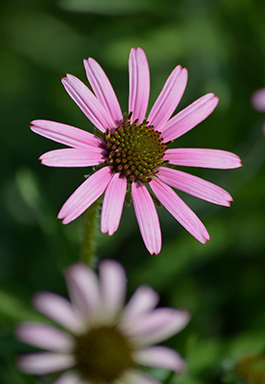| |
UT Gardens July 2016 Plant of the Month: Tennessee Purple Coneflower
By Justin Stefanski, UT Extension Horticulture Agent, Wilson County

The Tennessee purple coneflower (Echinacea tennesseensis), is a beautiful native plant that graces landscapes with blooms from June until September across much of the state. Photo by J. Stefanski, courtesy UTIA.
|
|
The Tennessee purple coneflower is a remarkable plant and should be held in high regard as a true Tennessee treasure. It was first discovered by botanists in 1878 within the cedar glades of the Central Basin of Tennessee, and remarkably, it is found nowhere else on earth. Its rarity is due in part to the unique conditions from which it naturally evolved.
Cedar glades are characterized by limestone outcroppings and dense stands of Eastern red cedar, post oak and hackberries. Also, many glades have extremely shallow soils that are often less than an inch deep. Amazingly, the cedar glades of Middle Tennessee are home to more endemic plant species than any other biome within our state. The Tennessee purple coneflower (Echinacea tennesseensis), along with numerous other rare endemic plants, have adapted to grow within the dry and shallow soils of the cedar glade and exhibit extreme drought tolerance.
By the mid twentieth century, few traces of this endemic beauty could be found within the glades, which were becoming increasingly threatened by urban and suburban development. However, five remaining populations were found within Davidson, Wilson and Rutherford counties in the late 1960’s and early 70’s, and botanists immediately went about ensuring the protection of these areas to safeguard the survival of the Tennessee purple coneflower. Additionally, in 1979 it was the first plant from Tennessee to be placed on the Federal List of Endangered and Threatened Plants. In 2011, after 30 years of rigorous conservation efforts, it was officially delisted from the federal list and has since become an increasingly common sight within the cedar glades and the home gardens of many plant lovers across Tennessee and beyond.
This perky Echinacea species is unique in its appearance, as its ray-like flowers have petals that tend to stand upright, making it easy to identify among other coneflowers. In the garden, this plant will typically grow to around two to three feet in height. It blooms heavily from June until September in much of the state and prefers full sun. It does best when planted in well-drained soil and tends to become excessively leggy when planted in highly nutritious soils with high organic matter. Based on my personal experience, plant them in the spot of your garden with the poorest soil, and you will be rewarded for it! They require little care in the garden due to their superb drought tolerance, and they are virtually pest-free.
Aesthetically speaking, the Tennessee purple coneflower looks best when planted in clusters of three to five, which gives them an overall appearance of a solid mound of blossoms. ‘Rocky Top’ is a commercially available variety and can be found at many garden centers. Be sure to leave a few spent flowers late into the fall, as they become irresistible to American gold finches, who sway gracefully atop the seed heads as they feed. Planting a few Tennessee purple coneflower in your garden will be sure to please as this native is a delight in the summer sunlight!
You can find beautiful plantings of Tennessee purple coneflower at all three UT Gardens locations.
The UT Gardens includes plant collections located in Knoxville, Jackson and Crossville. Designated as the official botanical garden for the State of Tennessee, the collections are part of the UT Institute of Agriculture. The gardens’ mission is to foster appreciation, education and stewardship of plants through garden displays, educational programs and research trials. The gardens are open during all seasons and free to the public. For more information visit the Gardens website: utgardens.tennessee.edu
Published June 30, 2016 |

